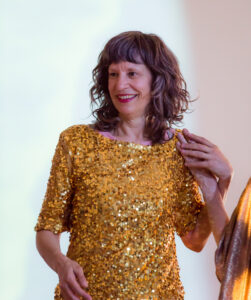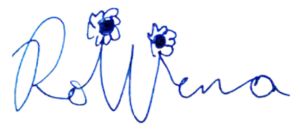
[ID: A 50 year-old white woman with dark hair cut in a shag, wearing a sequin gold top and bright red lipstick, smiles as she gazes over one shoulder, while gently cradling another dancer’s hand on her opposite shoulder. The photo is cropped from the elbows up against a white wall.]
Welcome, spring.
The articles and conversations in this issue — there are budding connections among them — explore the tension between what something is and what it means:
What is resistance, and what does it mean to Liz Duran Boubion? “To build a coalition [of co-resistance] implies that we are all connected to the suffering in Palestine.”
Why does contact improvisation matter to Jo Kreiter? “It matters as a carnival ride, inlaid into deep human connection…”
What does Joy Chenyu Lewis and Melissa Lewis Wong’s mother–child relationship mean through the prism of performance? “I [Melissa] saw my mom in a new way when she sang the Songhua River song.” “…and she [Melissa] appreciate my being Chinese, being somebody loves to sing.”
What is beauty and what does it mean to Michael French? “It has nothing to do with…aquiline noses, or the perversity of a white Jesus, or powdered wigs…”
To Honduran artists Diana Lara and Isadora Paz Taboada having Indigenous Lenca ancestors means: “The body and the expression of dance are rooted in…the exchange between tradition and modernity…between multiple identities.”
What is extended reality, and how will Yayoi Kambara use it? “To stimulate audiences into imagining a diverse community where colonial modernity converses with these majestic lands.”
What is “The People’s Palace?” And what does it mean?
This is a particularly central question in this issue of In Dance. Enjoy three articles on the topic from the perspective of: The People’s Palace creator Joanna Haigood; set designer Sean Riley; and “muser” Ellen Sebastian Chang.
“What avenue is open to us…who still have dreams (plans)…in this place we call home?” Sebastian Chang muses. “Do all avenues and roads lead to City Hall, aka ‘The People’s Palace?’”
The People’s Palace is a new site specific work by ZACCHO Dance Theatre. Conceived and directed by Joanna Haigood, it is set in the bustling, “like twenty weddings happening all at the same time,” laughs Haigood, San Francisco City Hall.
“The People’s Palace” is also the nickname for City Hall coined by mayor “Sunny Jim” Rolph when it opened in 1915. “At the end of the day… ‘the people’ are very specific and not inclusive,” Haigood tells maurya kerr. The Beaux Arts architectural style of City Hall was chosen to represent the ideals of whiteness.
Constructed whiteness. That’s what City Hall’s architecture means.
I’ve been to City Hall many times. I know what it is. I’m eager for it to mean something new. Come May 9th, 10th and 12th ZACCHO’s performance will transform City Hall’s architecture into: “…more inclusive narratives that more accurately reflect San Francisco’s diverse and dynamic cultures and community.”
This is one of the transformations — rebirths, unfoldings, blossomings, portals — I want to go through this season.
Welcome, spring!

This article appeared in the Spring 2024 issue of In Dance.

